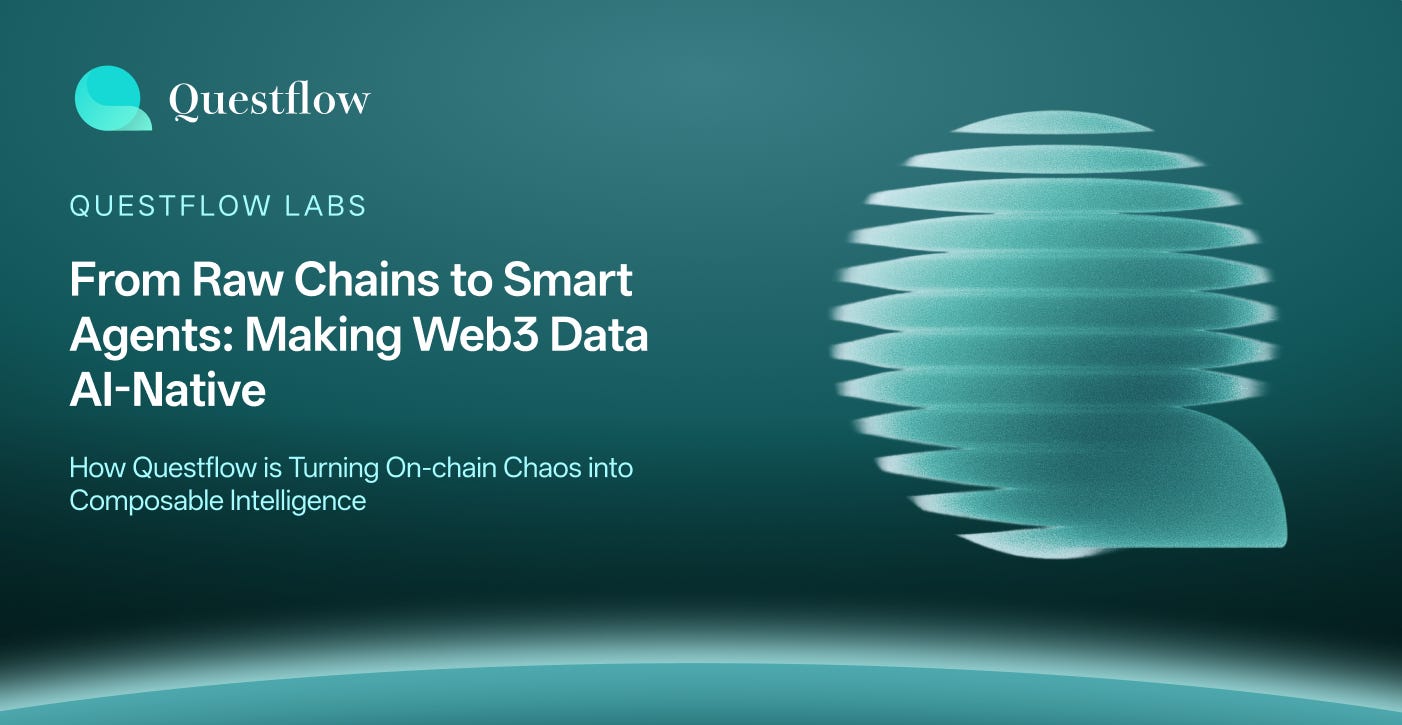From Raw Chains to Smart Agents: Making Web3 Data AI-Native
How Questflow is Turning On-chain Chaos into Composable Intelligence
Introduction
Web3 is built on data—blocks, transactions, contracts, DAOs, tokens, and user interactions. But while the blockchain excels at immutable logging, it was never designed to serve machine learning systems or AI agents. The result is a fractured landscape: rich with signals, yet barren in semantics.
This blog takes a detailed look at the current state of Web3 data + AI integration. We'll examine what's been achieved, what’s still missing, and why most platforms haven't yet made Web3 data truly agent-ready. Through comparison charts and practical insights, we’ll also explore how platforms like Questflow are reimagining agent ecosystems to unlock the next generation of autonomous Web3 apps.
What AI Can Do with Web3 Data Today
✅ What’s Already Working
These capabilities are mostly read-heavy and template-driven, relying on tools like Dune, Nansen, Flipside, and some custom-trained GPT agents on governance or protocol docs.
❌ What’s Still Missing
Even where AI meets Web3 data, the interface is fragile, inconsistent, and lacking semantic understanding. Developers have to stitch custom workflows by hand, hindering innovation.
Web2 vs Web3 Data for AI Agents – A Structural Comparison
Web2 succeeded by standardizing developer experiences. Web3, in contrast, remains fragmented and manually integrated—with each data source requiring custom adapters.
Case Study Comparison – Who’s Doing What
Insight: Most platforms serve human analysts or dashboards—not composable AI agents.
Why This Matters for Developers & Founders
If you're building:
A DeFi product that auto-adjusts user allocations
A DAO interface that summarizes and votes based on community sentiment
A Wallet UI that recommends financial actions
You need:
AI agents that can understand onchain events
Reliable access to unified, actionable data
Composable tools—not one-off integrations
Without standardized agent-ready data, every product team re-implements the same brittle adapters, hurting velocity and UX.
What the Industry Needs Next
1. AI-Native Web3 Data Standards
Open schemas for DAOs, NFTs, DeFi positions
Incentives to adopt these formats at indexer or RPC level
2. Composable Agent Runtimes
Reusable agents ("NFT Scorer", "Yield Optimizer") that plug into any app
Memory + coordination layers for swarms of agents
3. Fine-Tuned Models for Web3 Domains
LLMs trained on tx histories, governance threads, smart contract UIs
De-risked inference layers for critical onchain operations
4. Standard Agent Protocols
Like MAOP (Multi-Agent Orchestration Protocol) from Questflow
Lets agents discover, call, and validate each other’s output
How Questflow’s QDP Moves the Line
Questflow’s Developer Platform (QDP) is the first agent-native infrastructure focused on Web3 integration. Instead of exposing APIs, it turns services into agents that can:
Integrating data from onchain sources with QDP (e.g., Coingecko, StakeKit)
Trigger workflows (e.g., rebalance, claim, vote)
Talk to each other using MAOP
Be composed into swarms or deployed individually
Key Advantages
Example Use Cases
Social Media Agent Swarm: monitors, posts, replies on Twitter/X via agent rules
Auto-Yield Optimizer: connects StakeKit + Coingecko + Zapper to rebalance positions
Agent Payment: manage agentic wallets, distribution and judge
Developers no longer build scripts—they design swarms.
Looking Ahead
Expect massive growth in:
Composable Agent App Stores
Web3 vector stores for LLM grounding
Permissioned data layers (e.g., DAO votes, private zk txs)
Real-time agent observability tools
Standard agent testnets and sandboxes
Questflow is building toward this future by:
Offering public + private agent registries
Supporting vector memory, policy rules, and synthetic simulations
Onboarding Web3 APIs into QDP via MCP-style adapters
Conclusion: Web3’s Missing Multi Agent Orchestration Layer of DATA Is Being Built
Web3 doesn’t just need data—it needs agents that understand, coordinate, and act. Today, most data remains raw, disconnected, and non-semantic.
Questflow’s QDP is turning that around—one API, one protocol, and one swarm at a time.
Let the data work for you—not the other way around.







